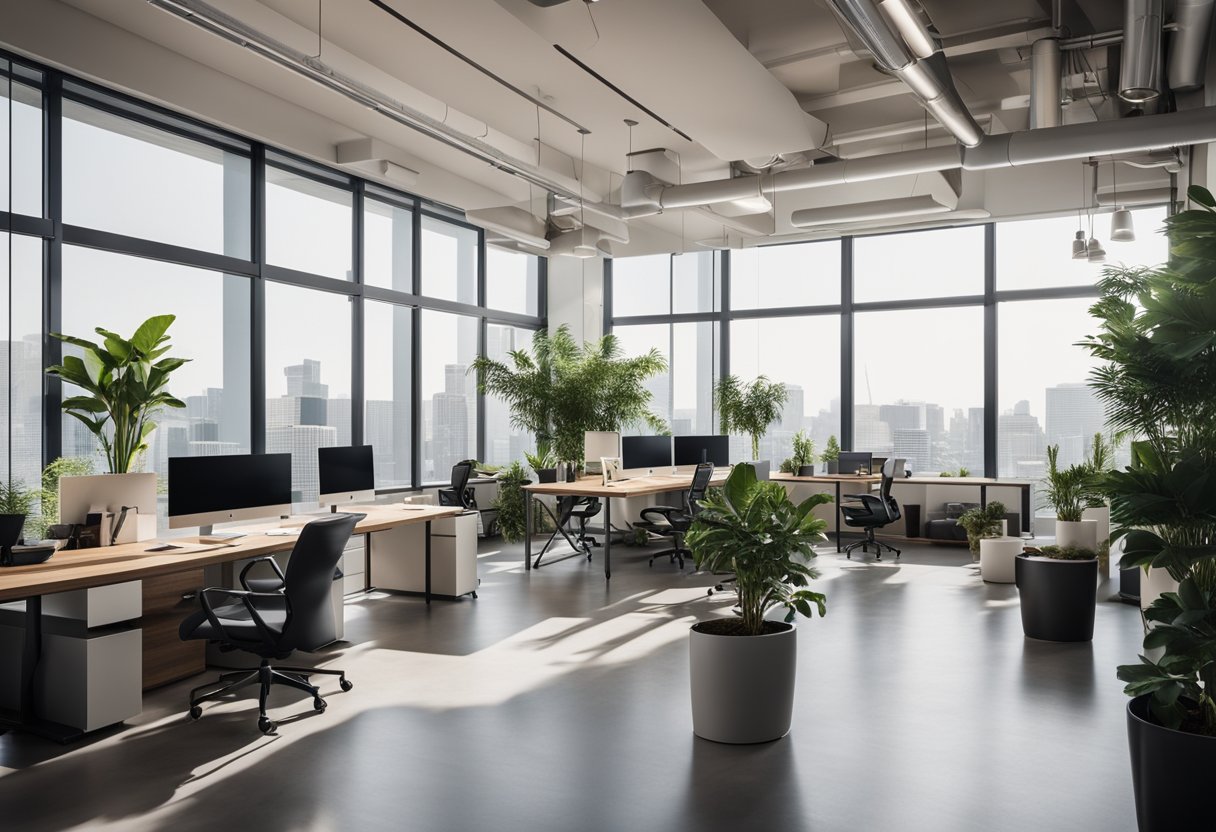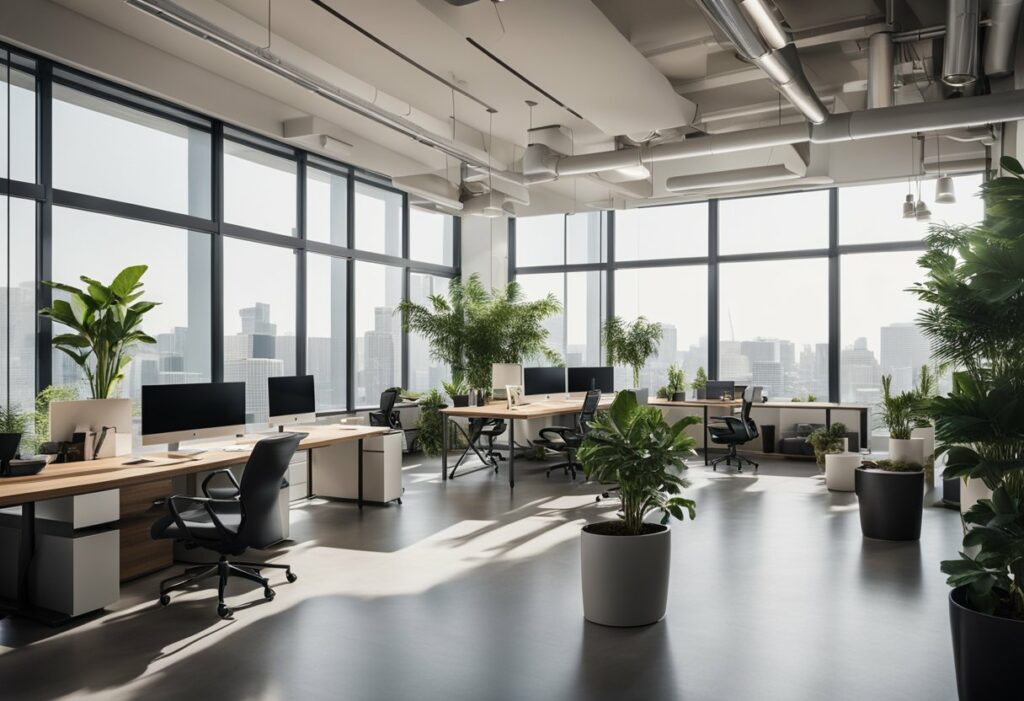Trendy Office Design: Creating a Modern Workspace
If you’re looking to revamp your office design, you’re in luck. The modern era has brought about a revolution in office design, with new trends emerging every year. These trends are not just about aesthetics but are also about creating a functional and comfortable workspace that prioritizes employee wellness and sustainability.

One of the most significant changes in office design is the move towards open-plan workspaces. This design encourages collaboration and communication between employees, making it easier for teams to work together. It also creates a more social and dynamic environment that can help boost productivity and creativity. Another trend is the use of natural light and greenery to create a more calming and relaxed atmosphere. Studies have shown that exposure to natural light can improve mood and energy levels, while plants can help purify the air and reduce stress.
So, if you’re looking to create a workspace that is not only functional but also aesthetically pleasing and comfortable, then it’s time to embrace the latest trends in office design. From open-plan workspaces to natural light and greenery, these trends are sure to revolutionize the way you work.
Key Takeaways
- Modern office design trends prioritize employee wellness and sustainability
- Open-plan workspaces and natural light and greenery are popular trends in office design
- These trends can improve collaboration, creativity, and productivity in the workplace.
Revolutionising Office Design for the Modern Era

The modern era has brought about a shift in the way we work. Nowadays, work is no longer confined to a physical office space, and employees have come to expect a workspace that is flexible, collaborative, and productive. Office design has a major role to play in meeting these expectations.
Embracing Biophilic Elements for Enhanced Well-Being
Biophilic design is the practice of incorporating natural elements into the built environment. This can include greenery, natural light, and other elements that mimic the natural world. By embracing biophilic design, you can create a workspace that promotes well-being and productivity.
Studies have shown that exposure to natural elements can reduce stress levels and boost creativity. By incorporating natural elements into your workspace, you can create a more pleasant and productive environment for your employees. This can include adding plants, using natural materials, and incorporating natural light.
Fostering Collaboration and Flexibility
Collaboration and flexibility are key components of a modern workspace. This means creating spaces that are designed for collaboration and allowing employees to work in a way that suits their needs.
Collaborative spaces can include open-plan offices, meeting rooms, and breakout areas. By creating spaces that are designed for collaboration, you can encourage teamwork and creativity. Flexible workspaces, such as hot-desking and remote working, can also help to promote flexibility and productivity.
Incorporating Technology for a Productive Workspace
Technology is an essential component of a modern workspace. By incorporating technology into your workspace, you can create a more productive and efficient environment for your employees.
This can include using tools such as video conferencing, project management software, and cloud-based storage. By using technology to streamline processes and improve communication, you can create a workspace that is more efficient and productive.
In conclusion, office design has a major role to play in creating a workspace that meets the needs of modern employees. By embracing biophilic design, fostering collaboration and flexibility, and incorporating technology, you can create a workspace that is both productive and enjoyable to work in.
Prioritising Employee Wellness and Sustainability

As companies continue to recognise the importance of employee well-being, office design trends have shifted towards creating spaces that prioritise the comfort and health of workers. At the same time, there is an increasing demand for sustainable and eco-friendly office environments that reduce waste and promote renewable energy.
Designing for Diversity and Inclusion
One important aspect of employee well-being is creating a workplace that is inclusive and accessible to everyone. This means designing spaces that are ADA compliant and accessible to people with disabilities, as well as creating an environment that promotes diversity and equity.
Consider incorporating diverse artwork, inclusive signage, and adjustable furniture that can accommodate a range of body types and abilities. This will help to create a welcoming and inclusive environment that supports the well-being of all employees.
Creating Spaces for Health and Movement
Movement and exercise are important for maintaining physical and mental health, so it’s important to design office spaces that encourage employees to move and stay active throughout the day.
Consider incorporating standing desks, comfortable seating, and ergonomic furniture that supports good posture and reduces the risk of injury. You could also create dedicated spaces for exercise or movement, such as yoga or meditation rooms, to promote mental and emotional well-being.
Building a Sustainable and Eco-Friendly Environment
In addition to promoting employee well-being, many companies are also prioritising sustainability and eco-friendliness in their office design. This means using natural materials, reducing waste, and promoting renewable energy sources.
Consider incorporating energy-efficient lighting, eco-friendly materials, and sustainable design elements such as living walls or green roofs. You could also encourage employees to reduce waste by providing recycling bins and encouraging the use of reusable water bottles and coffee cups.
By prioritising employee well-being and sustainability in your office design, you can create a space that supports the health and happiness of your employees while also reducing your environmental impact.
Frequently Asked Questions

How can I infuse my small office space with a contemporary aesthetic?
If you have a small office space, you can still incorporate a contemporary aesthetic by using a minimalist approach to design. Use light colours and simple lines to create a clean and uncluttered look. Consider using multifunctional furniture pieces that can serve multiple purposes to save space. You can also add a touch of nature to your office by incorporating plants, which are not only aesthetically pleasing but also have health benefits.
What are the essential elements to include in a modern home office?
A modern home office should be functional, comfortable, and visually appealing. Essential elements to include are a comfortable chair, a sturdy desk, good lighting, and adequate storage space. You should also consider incorporating technology such as a computer, printer, and other necessary devices. To add some personality to your home office, consider adding artwork or decorative pieces that inspire you.
What innovative design ideas can maximise productivity in a modern office layout?
Innovative design ideas can maximise productivity in a modern office layout by creating a space that promotes collaboration, creativity, and comfort. For example, you can use an open-plan layout that encourages communication and teamwork. You can also incorporate flexible workspaces that allow employees to work in different areas of the office. Another idea is to use natural light and greenery to create a calming and inspiring environment.
How do you balance functionality and style in a modern office interior?
To balance functionality and style in a modern office interior, you should focus on creating a space that is both practical and visually appealing. Choose furniture and decor that are both functional and aesthetically pleasing. Use colours and patterns that complement each other and create a cohesive look. You can also incorporate innovative technology that enhances productivity and adds a modern touch.
What are some exciting colour schemes for a modern office design?
Exciting colour schemes for a modern office design include bold and bright colours such as orange, yellow, and blue. You can also use neutral colours such as grey, beige, and white to create a clean and sophisticated look. Consider using colour accents to add interest and personality to your office.
How can technology be integrated into trendy office designs for enhanced efficiency?
Technology can be integrated into trendy office designs in many ways to enhance efficiency. For example, you can use smart lighting systems that automatically adjust to the time of day and the amount of natural light in the room. You can also use digital signage to communicate important information to employees. Another idea is to use cloud-based software that allows employees to collaborate and work remotely.



